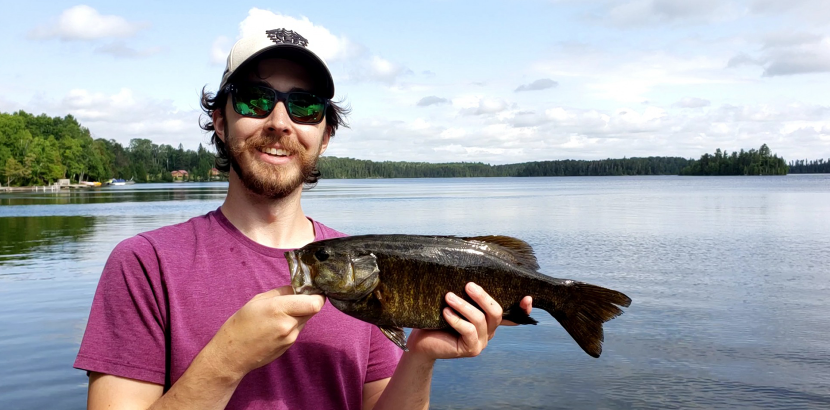Meet Phil Grayson, a new Banting Postdoctoral Fellow at UM.
Phil Grayson is a new Banting Postdoctoral Fellow in the Faculty of Science, studying one of two surviving groups of ancient jawless fishes: lampreys.
We caught up with him during this busy time before he takes up his Banting Fellowship in fall 2021, to learn more about him and his research. He will be working with Dr. Margaret Docker and Dr. Colin Garroway in the Department of Biological Sciences.
TELL US A BIT ABOUT YOURSELF AND YOUR AREA OF RESEARCH.
I was born in Winnipeg and grew up just outside the city, attending school in St. Andrews, Lockport, and Selkirk, before completing my undergraduate and master’s degrees at the University of Winnipeg. During my MSc, I attended a seminar at UM with Dr. Hopi Hoekstra from Harvard University as the invited speaker. I was inspired by her group’s work on the evolution of coat color in beach mice, illustrating the interconnectedness of the genes, physical traits, and selective advantage within differing environments. Through her, I was connected to Dr. Scott Edwards, the Curator of Ornithology at the Harvard Museum of Natural History and a world leader in the field of avian genomics. I applied to his laboratory and an NSERC Canada Graduate Scholarship and was successful with both applications. I completed my Ph.D. in the Department of Organismic and Evolutionary Biology at Harvard University in 2019, during which time I studied the development and genomics of large flightless birds like the emu, ostrich, and kiwi.
As an evolutionary biologist, my research combines developmental and computational biology with genetics and genomics to investigate the origin of complex phenotypes. In my spare time, I enjoy fishing, drumming, and attending concerts and music festivals. I currently live in Boston, where I work as a research associate (biologist & bioinformatician) at the Harvard Medical School. I will begin my Banting Postdoctoral Fellowship in September 2021.
WHAT ATTRACTED YOU TO THE UM AS A BANTING FELLOW?
Following my Ph.D., I began a postdoctoral fellowship with Drs. Margaret Docker and Colin Garroway at UM. During this fellowship, I carried out population genomics on invasive sea lamprey in search of a genomic basis of sex. Drs. Docker and Garroway have had great success in recent years with funding through the Great Lakes Fishery Commission for work on sea lamprey, and so, I had the pleasure of mentoring and collaborating with many new students and postdocs during my time in their labs. Together, we uncovered a compelling signal in the genomic data from nearly 300 sea lamprey which laid the foundation for my Banting Fellow application.
I was incredibly lucky to have already had the opportunity to work alongside Drs. Docker and Galloway during my first fellowship at UM and were very hopeful that I would receive the Banting Fellowship to continue that collaboration. In academia, you often have to compromise between a number of things, including where you live, who you work with, and what you work on. My experience in the Department of Biological Sciences went against the grain in that I had excellent mentors and collaborators, alongside an opportunity to work on an exciting system in a place that I call home.
WHAT DO YOU HOPE TO ACHIEVE WITH YOUR RESEARCH PROGRAM?
Drs. Docker and Garroway have created a sea lamprey genomics hub at UM. The funding, expertise, and datasets available here mean that my proposed work could not be completed elsewhere in Canada, or the world, at this time. The Banting Postdoctoral Fellowship will provide me an incredible opportunity to build my independent research program primarily focused on two native lamprey species, the northern brook, and silver lamprey, alongside the sea lamprey. My aim is to build a research program that will allow me to secure my own laboratory, where I can continue to mentor students and carry out the research that I love, which incorporates genomics and developmental biology to study complex traits.
The funding, expertise, and datasets available here mean that my proposed work could not be completed elsewhere in Canada, or the world, at this time.
WHAT (OR WHO) INSPIRES YOU?
Broadly, I am inspired by the beauty and complexity of the natural world. I find that I am most at peace while hiking or fishing next to a body of water with all the sights, sounds, and smells that that experience provides.
I have also been inspired by many brilliant mentors, lab mates, and colleagues throughout my career, many of whom are not only pushing science forward but are also tackling many of the difficult issues of social inequality in academia. If I had to choose just one (whom I haven’t mentioned already), it would be Dr. Shane Campbell-Staton, who is about to move his young lab from UCLA to Princeton.
Research at the University of Manitoba is partially supported by funding from the Government of Canada Research Support Fund.

